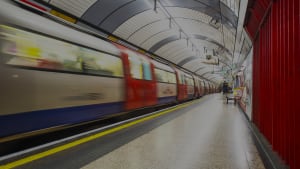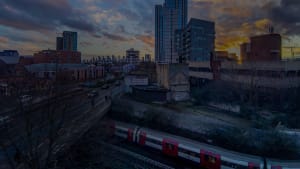EQUITABLE INFRASTRUCTURE: CREATING OPPORTUNITIES FOR EVERYONE IS GOOD FOR BUSINESS
The Future of Infrastructure
Infrastructure has the power to create opportunities, but historically the access it enables hasn’t been equal. Through lack of vision, accident and sometimes with intent, infrastructure has in some places contributed to systemic inequality by dividing people and creating barriers to opportunity. Going forward, AECOM’s Kelli Bernard says businesses will gain from doing more to ensure infrastructure is inclusive, not divisive.
As practitioners, many talk of infrastructure in terms of engineering and design and not enough in terms of its role at the heart of our societies. But if we look at the origin of the word – a combination of ‘infra’, meaning below, and ‘structure’ – we are reminded that infrastructure is by definition “the underlying structure of a country and its economy.”
It is perhaps not surprising therefore that infrastructure has historically been used as a tool of the dominant, perpetuating inequalities in some places and contributing to systemic racism. Existing communities have often had to pay the price of future possibilities, with some forced off the land they’ve lived on for generations or made to live next to power plants or wastewater treatment facilities. When large infrastructure is built through or in poor neighborhoods, the negative impacts can be long lasting for communities whose quality of life is impacted and/or who are cut off from economic opportunities and each other. Lack of sufficient infrastructure is also holding back communities, for example those forced to live with poor drinking water or internet access. The coronavirus pandemic has exposed the impacts of these racial disparities which help explain why Black people face higher risks and access to coronavirus testing may depend on where you live.
It doesn’t need to be this way. When designed in the interests of the greater good – and that includes business – infrastructure has the ability to transform, connect, empower and improve communities. As I discussed with fellow panelists at the United for Infrastructure conference last week, our freeways, bridges, housing (re)developments, power plants, water treatment facilities, and ports can all be tools to overcome some of the fundamental inequalities and inequities of the past. As practitioners we know what needs to be done.
overcoming inequity
The recent #BlackLivesMatter protests have prompted reflection globally about how to counter the systemic racism that exists in our society. In the corporate sector there is a growing recognition that government regulations haven’t been enough – and the onus is on business to do more.
The infrastructure industry is no different. We need to encourage a more diverse talent pool and leadership, but we also need to think about the impact of the structures that we build. From active attempts by some urban and transportation planners to keep communities apart to systemic challenges around poverty and the lack of access to jobs and education, clean water and the internet, there is much the infrastructure industry needs to learn and address to overcome fundamental inequities across our societies .
This is already starting to happen. In Atlanta, an abandoned railroad track turned pedestrian path is connecting communities and erasing a redline that once separated them. In Los Angeles, a 15.2-mile metro transit system extending from downtown Los Angeles to Santa Monica is connecting underserved communities and people to job-rich centers on the west side. And in Phoenix, Arizona, a 5.5 mile transit system linking South Central to Downtown was accompanied by a workforce and educational program to provide opportunities for those most impacted by the project.
What connects these projects? Each one delivers social impact dividends and addresses pressing challenges that extend value beyond the more traditional economic benchmarks guiding most infrastructure investment today.
Five considerations for equitable infrastructure
To create equitable infrastructure which offers opportunities for all, we need processes that are inclusive and affirming. That isn’t always the case.
Here we set out five considerations that we think equitable infrastructure practitioners should take on board.
1/ Participatory decision-making
Impacted communities need to be engaged and listened to from the outset. Consultation needs to start before decisions have been taken, otherwise it looks at best like a problem-solving exercise – what should we do about those people who have to live next to the power station? – or at worst like a tick-box exercise. It can also be in the interest of business, who have a much better picture of the risk-benefit analysis when it comes to making the case for funding.
2/ Authenticity
There is a lot of distrust in communities who have traditionally been ignored, so to get community engagement, you need to convince people they will have an impact – and follow through. This is best achieved though in-person contact and outreach, engaging with community leaders and convincing them their concerns will be taken seriously.
3/ Diversity of decision making
To ensure racial inequity is not built into the system, it matters who is at the table. We could learn from AECOM’s Office of Native Sovereign and Tribal Relations, which focuses on improving the quality of AECOM products and services for clients with projects that involve engagement with American Indian tribes, Native Alaskan villages, or Hawaiian communities. The office invites Indigenous People to be part of the process as partners, not stakeholders. Partners have a say in what is happening, whereas stakeholders are parties whose interests may or may not be taken into account.
The need for diversity should be reflected through the supply chain, and efforts should also be made to engage and employ local businesses in the process.
4/ Social benefit
We need to change the way we make the case for infrastructure investment to look at true costs and benefits – social, environmental as well as economic. It might make economic sense to site a power station in a poor community where the land is cheaper, but socially the costs might be unacceptable. Equally, the social benefits of connecting a poorer community with economic opportunities in a richer part of town should be valued at least as much as the uplift in property values.
5/ Legacy
Once a project is delivered, oftentimes those who’ve delivered it step away. This arrangement means the designers of a project aren’t as invested in its outcomes as they could be. Perhaps for this reason, diversity considerations sometimes fall down the priority list after a bid is won. To change this mentality, we should change the way contracts are awarded to ensure a greater investment in outcomes for the affected communities.
At AECOM, we believe infrastructure has the power to alleviate today’s economic and social distress, whilst creating opportunities for generations to come. As we take heed of the reflections prompted by the #BlackLivesMatter protests and the hardships of coronavirus, we need to take greater care to ensure the legacy of our infrastructure is egalitarian.
If we are to #RebuildBetter and create structures are not only best in the world but best for the world, we need participatory decision-making, authenticity, diversity of decision-making and a focus on social benefits and legacy. It’s time for our industry to build a better future than it has sometimes done in the past.
Phoenix South Central Light Rail Transit internship program
In Phoenix, Arizona, the South Central Light Rail Extension (LRT)/Downtown Hub - slated for a 2023 completion – will link the South Central Phoenix Community to Downtown Phoenix. AECOM, working with the City and the Valley Metro Rail Inc. (VMR) transit agency, developed a workforce and educational program to provide opportunities for those most impacted by the project.
South Phoenix is diverse, with a population that is 63 percent Latino and 16 percent African American. One in seven residents live in poverty and 49 percent of jobs pay less than $15 an hour. It is estimated that 20 percent do not speak English well.
Outreach activities with 14 schools and a number of community organisations publicised the internship and invited applications. Essay workshops were held to help students prepare. Of the15 high school students selected to participate in 2018 and 2019, many showed an interest in careers in engineering, architecture, urban planning and related professions. Already one student, a senior in 2018, is now attending engineering school at Arizona State University.
Students received education regarding engineering and design principles, technologies and experiential activities which they put into practice during site visits with engineers, architects and urban planners. They were also offered college application help, resources for financial aid counseling, voluntary ongoing mentoring, and a $1,000 stipend.
-
ArticleTomorrow
![]()
Mind the gap
The future of mass transit systems
As coronavirus-related government restrictions ease, social distancing requirements pose enormous challenges for the operators of mass transit systems, many of whom have also seen a huge drop in farebox revenue. Given the critical importance of public transport in enabling accessible, equitable, and sustainable cities, AECOM’s Veronica Siranosian and Joe Seymour say proactive action is needed to support its long-term resiliency.Mind the gapAs coronavirus-related government restrictions ease, social distancing requirements pose enormous challenges for the operators of mass transit systems. Proactive action is needed to support long-term resiliency. -
ArticleSocial, Future
![]()
Social impact: Building a better case for infrastructure Investment
Measuring social impact
As we look towards recovery, there’s a danger that economic concerns dominate infrastructure decisions. To support those most hurt by coronavirus, social impact should be a key driver for investment.Social impact: Building a better case for infrastructure InvestmentAs we look towards recovery, there’s a danger that economic concerns dominate infrastructure decisions. To support those most hurt by coronavirus, social impact should be a key driver for investment. -
ArticleSocial
![]()
A 'force for good'
Maximising social value when delivering public sector contracts
We gathered experts from across the public, third and private sector to discuss “What does Social Value mean for the built environment professional services industry?”A 'force for good'We gathered experts from across the public, third and private sector to discuss “What does Social Value mean for the built environment professional services industry?”






